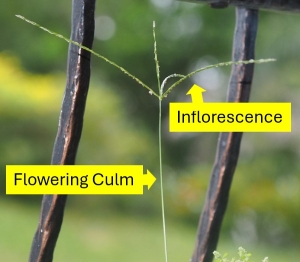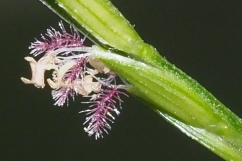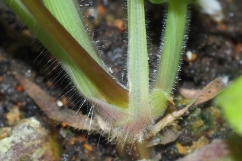| Home | Nature Weekly Index |
13 April 2025 | Digitaria ciliaris | Tropical Finger-grass |
 |
| Fig. 1: Inflorescence of Digitaria ciliaris |
During the first week of March, I conducted an investigation into a wild grass species belonging to the family Poaceae, which is growing in the park adjacent to my residence. The flowering culm, or aerial stem supporting the inflorescence (Fig. 1), measures approximately 60 centimetres in height from the base of the plant. Typically, each culm features between 3 to 6 branches of inflorescences at its distal end.
Based on the overall characteristics of the grass, the initial identification suggested it was a Digitaria species. However, its characteristics do not fully align with any of the three Digitaria species listed on my website, specifically Digitaria bicornis, Digitaria didactyla, and Digitaria longiflora. I subsequently reviewed the list of Digitaria species from the latest Singapore flora checklist. Although 10 species are listed, they provided little insight into the particular Digitaria species under examination.
Nevertheless, the Poaceae section of the 2019 Flora of Singapore includes a set of images on Digitaria ciliaris (page 305) that closely match the plant in question. The detailed botanical descriptions, albeit somewhat complex for me, indicate that this grass species may indeed be Digitaria ciliaris. Identifying grass species, particularly those within the same genus, remains challenging. For now, I will classify this grass species as Digitaria ciliaris until further evidence suggests otherwise.
A fruit can be simply defined as a ripened ovary containing seeds. The fruit of grasses is known as grain or by the botanical term caryopsis, which refers to a specialized type of dry, one-seeded fruit where the thin ovary wall tightly adheres to the seed. Another type of dry, one-seeded fruit is achene, where the ovary wall does not adhere to the seed. In the enlarged image of the grains from Digitaria ciliaris, dense hairs can be observed along the edge of the grains (Fig. 2a).
A seedling of Digitaria ciliaris was discovered in a pot in the second week of March. Its identity was confirmed when it produced its first inflorescence in the third week of March. It is possible that a seed was unintentionally placed in the pot while handling the Digitaria species brought back earlier. Since the two previously collected specimens lacked some features, this potted specimen provided an opportunity to capture additional images of the grass. For instance, the enlarged images of the grains, which are approximately 3 millimetres long, were obtained from the first inflorescence of this potted specimen.
Observations of the potted specimen indicate that the initial inflorescence emerges from the fifth node (stem joint). The flower's stigma exhibits a purplish hue (Fig. 2b). Nodes following the first are devoid of hairs, with the exception of a concentration of long hairs around the collar region (Fig. 2c) while the remainder of the sheath is hairless. The base of the plant exhibits a relatively dense covering of hairs (Fig. 2d).
| (a) Grains (fruits) | (b) Flower | (c) Collar and node | (d) Hairy base |
 |
 |
 |
 |
| Fig. 2 (a-d): Characteristics of selected plant parts of Digitaria ciliaris | |||
The specimen will remain in the pot until further image collection of this plant is no longer required.